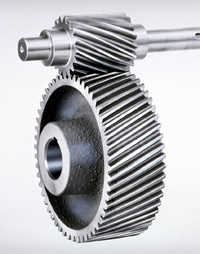is a refinement over spur gears. The leading edges of the
teeth are not parallel to the axis of rotation, but are set at an angle.
Since the gear is curved, this angling causes the tooth shape to be a
segment of a helix. The angled teeth engage more gradually than do spur gear
teeth. This causes helical gears to run more smoothly and quietly than spur
gears. Helical gears also offer the possibility of using non-parallel
shafts. A pair of helical gears can be meshed in two ways: with shafts
orientated at either the sum or the difference of the helix angles of the
gears. These configurations are referred to as parallel or crossed,
respectively. The parallel configuration is the more mechanically sound. In
it, the helices of a pair of meshing teeth meet at a common tangent, and the
contact between the tooth surfaces will, generally, be a curve extending
some distance across their face widths. In the crossed configuration, the
helices do not meet tangentially, and only point contact is achieved between
tooth surfaces. Because of the small area of contact, crossed helical gears
can only be used with light loads.

HELICAL GEARS